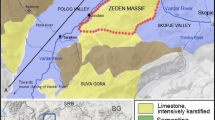Abstract
3H and 35S activity in precipitation was analyzed to evaluate short and medium groundwater age. Precipitation sample was collected from Feb-2020 to May-2021 at rainy day. Tritium activity in precipitation ranged from 0.5 to 11.2 TU and 35S activity ranged from 10.1 to 97.7 mBq/L. 3H and 35S activity correlated and their contents are high in spring while Jun ~ Aug precipitation sample was low due to marine air mass introduction. The 3H and 35S activity of some karst groundwaters were analyzed.




Similar content being viewed by others
References
Solomon DK, Cook PG (2000) In: Cook PG, ALed H (eds) Environmental tracers in subsurface hydrology. Kluwer Academic Publishers, Boston
Bethke CM, Johnson TM (2008) Groundwater age and groundwater age dating. Annu Rev Earth Planet Sci 36:121–152
Kazemi GA, Lehr JH, Perrochet P (2006) Groundwater age. Wiley , New York, NJ
Weissmann GS, Zhang Y, LaBolle EM, Fogg GE (2002) Dispersion of groundwater age in an alluvial aquifer system. Water Resour Res 38(10):1198–1211
Lin M, Wang K, Kang S, Thiemens MH (2017) Simple method for high-sensitivity determination of cosmogenic 35S in snow and water samples collected from remote regions. Anal Chem 89(7):4116–4123
Deinhart A, Bibby R, Roberts S, Tompson A, Esser B (2017) The analysis of Sulfur-35 as a young groundwater at E-Tunnel, Rainier Mesa, Nevada national security site. Lawrence Livermore National Laboratory, Livermore
Schubert M, Knoller K, Tegen I, Terzi L (2020) Variability of cosmogenic 35S in rain-resulting implications for the use of radiosulfur as natural groundwater residence time tracer. Water 12(10):2953. https://doi.org/10.3390/w12102953
Urióstegui SH, Bibby RK, Esser BK, Clark JF (2015) Analytical method for measuring cosmogenic 35S in natural waters. Anal Chem 87(12):6064–6070
Tanaka N, Turekian K (1995) Determination of the dry deposition flux of SO2 using cosmogenic 35S and 7Be measurements. J Geophys Res Atmos 100(D2):2841–2848
Hong YL, Kim G (2005) Measurement of cosmogenic 35S activity in rainwater and lake water. Anal Chem 77(10):3390–3393
Oh YH, Yoon YY, Koh DC, Ko KS (2019) Measuring cosmogenic 35S in natural waters using largevolume liquid scintillation counting. J Radioanal Nucl Chem 322:1739–1745
Yoon YY, Kim KJ, Lee KY, Ko KS (2010) Tritium concentration in rain with seasonal variation. Anal Sci Technol 23(2):161–164
Michel RL, Naftz DL (1995) Use of sulfur-35 and tritium to study runoff from an alpine glacier, wind River range, Wyoming. IAHS Publ Ser Proc Reports Int Assoc Hydrol Sci 228:441–444
Urióstegui SH, Bibby RK, Esser BK, Clark (2016) Quantifying groundwater travel time near managed recharge operations using 35S as an intrinsic tracer. J Hydrol 543:145–154
Acknowledgements
This work was supported by the Basic Research Project (22–3411) of the Korea Institute of Geoscience and Mineral Resources (KIGAM) funded by the Ministry of Science and Information and Communications Technology and the National Research Council of Science & Technology (NST) grant by the Korean government (MSIP) (No. CAP-17–05-KIGAM).
Author information
Authors and Affiliations
Corresponding author
Ethics declarations
Competing Interests
The authors declare that they have no known competing financial interests or personal relationships that could have appeared to influence the work reported in this paper.
Additional information
Publisher’s Note
Springer Nature remains neutral with regard to jurisdictional claims in published maps and institutional affiliations.
Rights and permissions
Springer Nature or its licensor (e.g. a society or other partner) holds exclusive rights to this article under a publishing agreement with the author(s) or other rightsholder(s); author self-archiving of the accepted manuscript version of this article is solely governed by the terms of such publishing agreement and applicable law.
About this article
Cite this article
Yoon, Y.Y., Ko, K.S. & Lee, J.M. Tritium and 35S activity variation in precipitation in Korea and its application to groundwater age determination. J Radioanal Nucl Chem 332, 1917–1921 (2023). https://doi.org/10.1007/s10967-023-08888-3
Received:
Accepted:
Published:
Issue Date:
DOI: https://doi.org/10.1007/s10967-023-08888-3




